初中英语时态总结及专项练习.docx
《初中英语时态总结及专项练习.docx》由会员分享,可在线阅读,更多相关《初中英语时态总结及专项练习.docx(22页珍藏版)》请在冰豆网上搜索。

初中英语时态总结及专项练习
初中英语时态总结
一、一般现在时
1.概念:
经常、反复发生的动作或行为及现在的某种状况。
2.时间状语:
Always,usually,often,sometimes,everyweek(day,year,month…),onceaweek(day,year,month…),onSundays,
3.基本结构:
动词原形(如主语为第三人称单数,动词上要改为第三人称单数形式)
4.否定形式:
主语+am/is/are+not+其他;此时态的谓语动词若为行为动词,则在其前加don't,如主语为第三人称单数,则用doesn't,同时还原行为动词。
5.一般疑问句:
把be动词放于句首;用助动词do提问,如主语为第三人称单数,则用does,同时,还原行为动词。
6.例句:
.Itseldomsnowshere.
Heisalwaysreadytohelpothers.
Actionspeakslouderthanwords..
动词+s的变化规则
1.一般情况下,直接加-s,如:
cook-cooks,milk-milks
2.以s.x.sh.ch.o结尾,加-es,如:
guess-guesses,wash-washes,watch-watches,go-goes
3.以“辅音字母+y”结尾,变y为i,再加-es,如:
study-studies
二、一般过去时
1.概念:
过去某个时间里发生的动作或状态;过去习惯性、经常性的动作、行为。
2.时间状语:
ago,yesterday,thedaybeforeyesterday,lastweek,last(year,night,month…),in1989,justnow,attheageof5,oneday,longlongago,onceuponatime,etc.
3.基本结构:
be动词;行为动词的过去式
4.否定形式:
主语+was/were+not+其他;在行为动词前加didn't,同时还原行为动词。
5.一般疑问句:
was或were放于句首;用助动词do的过去式did提问,同时还原行为动词。
6.例句:
Sheoftencametohelpusinthosedays.
Ididn'tknowyouweresobusy.
动词过去式变化规律
①一般情况下,在动词原形后直接加ed。
如:
wanted,played。
②以不发音的字母e结尾的动词,直接加d。
如:
hoped,lived。
③重读闭音节单词需双写最后一个辅音字母,再加ed。
如:
stopped,shipped。
④以辅音字母+y结尾的动词变y为i,再加ed。
如:
studied,worried。
⑤有些动词不符合上面的规则,需要特殊记忆。
三、现在进行时
1.概念:
表示现阶段或说话时正在进行的动作及行为。
2.时间状语:
Now,atthistime,days,etc.look.listen
3.基本结构:
主语+be+doing+其他
4.否定形式:
主语+be+not+doing+其他
5.一般疑问句:
把be动词放于句首。
6.例句:
Howareyoufeelingtoday?
Heisdoingwellinhislessons.
动词加ing的变化规则
1.一般情况下,直接加ing,如:
cook---cookingwork---working
2.以不发音的e结尾,去e加ing,如:
make-making,taste-tasting
3.如果末尾是一个元音字母和一个辅音字母,双写末尾的辅音字母,再加ing,如:
run-running,stop-stopping
四、现在完成时
1.概念:
过去发生或已经完成的动作对现在造成的影响或结果,或从过去已经开始,持续到现在的动作或状态。
2.时间状语:
yet,already,just,never,ever,sofar,bynow,since+时间点,for+时间段,recently,lately,inthepastfewyears,etc.
3.基本结构:
主语+have/has+p.p(过去分词)+其他
4.否定形式:
主语+have/has+not+p.p(过去分词)+其他
5.一般疑问句:
have或has。
6.例句:
I'vewrittenanarticle.
Thecountrysidehaschangedalotinthepastfewyears.
五、一般将来时
1.概念:
表示将要发生的动作或存在的状态及打算、计划或准备做某事。
2.时间状语:
Tomorrow,nextday(week,month,year…),soon,inafewminutes,by…,thedayaftertomorrow,etc.
3.基本结构:
主语+am/is/are+goingto+do+其他;主语+will/shall+do+其他
4.否定形式:
主语+am/is/arenotgoingtodo;主语+will/shallnotdo+其他
5.一般疑问句:
be放于句首;will/shall提到句首。
6.例句:
Theyaregoingtohaveacompetitionwithusinstudies.
Itisgoingtorain.
名词复数的不规则变化
1)child---childrenfoot---feettooth---teeth
mouse---miceman---menwoman---women
注意:
与man和woman构成的合成词,其复数形式也是-men和-women。
如:
anEnglishman,twoEnglishmen.但German不是合成词,故复数形式为Germans;Bowman是姓,其复数是theBowmans。
2)单复同形如:
deer,sheep,fish,Chinese,Japanese
li,jin,yuan,twoli,threemu,fourjin
但除人民币元、角、分外,美元、英镑、法郎等都有复数形式。
如:
adollar,twodollars;ameter,twometers
3)集体名词,以单数形式出现,但实为复数。
如:
people.police.cattle等本身就是复数,不能说apeople,apolice,acattle,但可以说
aperson,apoliceman,aheadofcattle,theEnglish,theBritish,theFrench,theChinese,theJapanese,theSwiss等名词,表示国民总称时,作复数用。
如:
TheChineseareindustriesandbrave.中国人民是勤劳勇敢的。
4)以s结尾,仍为单数的名词,如:
a.maths,politics,physics等学科名词,为不可数名词,是单数。
b.news是不可数名词。
c.theUnitedStates,theUnitedNations应视为单数。
TheUnitedNationswasorganizedin1945.联合国是1945年组建起来的。
d.以复数形式出现的书名,剧名,报纸,杂志名,也可视为单数。
"TheArabianNights"isaveryinterestingstory-book.
<<一千零一夜>>是一本非常有趣的故事书。
5)表示由两部分构成的东西,如:
glasses(眼镜)trousers,clothes
若表达具体数目,要借助数量词pair(对,双);suit(套);apairofglasses;twopairsoftrousers
6)另外还有一些名词,其复数形式有时可表示特别意思,如:
goods货物,waters水域,fishes(各种)鱼
一、一般现在时
1.概念:
经常、反复发生的动作或行为及现在的某种状况。
2.时间状语:
Always,usually,often,sometimes,everyweek(day,year,month…),onceaweek(day,year,month…),onSundays,
3.基本结构:
动词原形(如主语为第三人称单数,动词上要改为第三人称单数形式)
4.否定形式:
主语+am/is/are+not+其他;此时态的谓语动词若为行为动词,则在其前加don't,如主语为第三人称单数,则用doesn't,同时还原行为动词。
5.一般疑问句:
把be动词放于句首;用助动词do提问,如主语为第三人称单数,则用does,同时,还原行为动词。
6.例句:
.Itseldomsnowshere.
Heisalwaysreadytohelpothers.
Actionspeakslouderthanwords..
[编辑本段]二、一般过去时
1.概念:
过去某个时间里发生的动作或状态;过去习惯性、经常性的动作、行为。
2.时间状语:
ago,yesterday,thedaybeforeyesterday,lastweek,last(year,night,month…),in1989,justnow,attheageof5,oneday,longlongago,onceuponatime,etc.
3.基本结构:
be动词;行为动词的过去式
4.否定形式:
主语+was/were+not+其他;在行为动词前加didn't,同时还原行为动词。
5.一般疑问句:
was或were放于句首;用助动词do的过去式did提问,同时还原行为动词。
6.例句:
Sheoftencametohelpusinthosedays.
Ididn'tknowyouweresobusy.
[编辑本段]三、现在进行时
1.概念:
表示现阶段或说话时正在进行的动作及行为。
2.时间状语:
Now,atthistime,days,etc.look.listen
3.基本结构:
主语+be+doing+其他
4.否定形式:
主语+be+not+doing+其他
5.一般疑问句:
把be动词放于句首。
6.例句:
Howareyoufeelingtoday?
Heisdoingwellinhislessons.
[编辑本段]四、过去进行时
1.概念:
表示过去某段时间或某一时刻正在发生或进行的行为或动作。
2.时间状语:
atthistimeyesterday,atthattime或以when引导的谓语动词是一般过去时的时间状语等。
3.基本结构主语+was/were+doing+其他
4.否定形式:
主语+was/were+not+doing+其他
5.一般疑问句:
把was或were放于句首。
(第一个字母大写)
6.例句:
AtthattimeshewasworkinginaPLAunit.
Whenhecamein,Iwasreadinganewspaper.
[编辑本段]五、现在完成时
1.概念:
过去发生或已经完成的动作对现在造成的影响或结果,或从过去已经开始,持续到现在的动作或状态。
2.时间状语:
yet,already,just,never,ever,sofar,bynow,since+时间点,for+时间段,recently,lately,inthepastfewyears,etc.
3.基本结构:
主语+have/has+p.p(过去分词)+其他
4.否定形式:
主语+have/has+not+p.p(过去分词)+其他
5.一般疑问句:
have或has。
6.例句:
I'vewrittenanarticle.
Thecountrysidehaschangedalotinthepastfewyears.
[编辑本段]六、过去完成时
1.概念:
以过去某个时间为标准,在此以前发生的动作或行为,或在过去某动作之前完成的行为,即“过去的过去”。
2.时间状语:
Before,bytheendoflastyear(term,month…),etc.
3.基本结构:
主语+had+p.p(过去分词)+其他
4.否定形式:
主语+had+not+p.p(过去分词)+其他
5.一般疑问句:
had放于句首。
6.例句:
Assoonaswegottothestation,thetrainhadleft.
Bytheendoflastmonth.Wehadreviewedfourbooks
基本结构:
主语+had+p.p(过去分词)+其他
①肯定句:
主语+had+p.p(过去分词)+其他
②否定句:
主语+had+not+p.p(过去分词)+其他
③一般疑问句:
Had+主语+p.p(过去分词)+其他
④特殊疑问句:
特殊疑问词+一般疑问句
[编辑本段]七、一般将来时
1.概念:
表示将要发生的动作或存在的状态及打算、计划或准备做某事。
2.时间状语:
Tomorrow,nextday(week,month,year…),soon,inafewminutes,by…,thedayaftertomorrow,etc.
3.基本结构:
主语+am/is/are+goingto+do+其他;主语+will/shall+do+其他
4.否定形式:
主语+am/is/arenotgoingtodo;主语+will/shallnotdo+其他
5.一般疑问句:
be放于句首;will/shall提到句首。
6.例句:
Theyaregoingtohaveacompetitionwithusinstudies.
Itisgoingtorain.
[编辑本段]八、过去将来时
1.概念:
立足于过去某一时刻,从过去看将来,常用于宾语从句中。
2.时间状语:
Thenextday(morning,year…),thefollowingmonth(week…),etc.
3.基本结构:
主语+was/were+goingto+do+其他;主语+would/should+do+其他
4.否定形式:
主语+was/were/not+goingto+do;主语+would/should+not+do.
5.一般疑问句:
was或were放于句首;would/should提到句首。
6.例句:
HesaidhewouldgotoBeijingthenextday.
Iaskedwhowasgoingthere.
[编辑本段]九、将来完成时
1.概念:
在将来某一时刻之前开始的动作或状态
2.时间状语:
bythetimeof;bytheendof+时间短语(将来);bythetime+从句(将来)
3.基本结构:
主语+begoingto/will/shall+have+p.p(过去分词)+其他
4例句:
Bythetimeyougetback,greatchangeswillhavetakenplaceinthisarea.
[编辑本段]十、现在完成进行时
1.概念:
表示从过去某一时间开始一直延续到现在的动作。
这一动作可能刚刚开始,也可能仍在继续,并可能延续到将来。
2.基本结构:
主语+have/has+been+doing+其他
3.时间状语:
since+时间点,for+时间段等。
4.例子:
Ihavebeensittinghereforanhour.
ThechildrenhavebeenwatchingTVsincesixo'clock.
[编辑本段]十一、一般过去时与现在完成时的转换
在现在完成时中,延续性动词能与表示一段时间的状语连用,瞬间动词却不能。
但是,可用别的表达方式:
①瞬间动词用于“一段时间+ago”的一般过去时的句型中;②瞬间动词可改成与之相对应的延续性动词及短语,与一段时间连用;③瞬间动词用于“Itis+一段时间+since+一般过去时”的句型中,表示“自从……以来有……时间”的意思,主句一般用itis来代替Ithasbeen;④瞬间动词用于“Sometimehaspassedsince+一般过去时”的句型中。
请看:
A.HejoinedtheLeaguetwoyearsago.
B.HehasbeenintheLeaguefortwoyears.
C.ItistwoyearssincehejoinedtheLeague.
D.TwoyearshaspassedsincehejoinedtheLeague.
[编辑本段]十二、一般现在时与现在进行时的转换
在一般现在时中,at加上名词表示“处于某种状态”,如atwork(在工作),atschool(上学、上课)等。
此短语可与进行时态转换。
请看:
Peterisatwork,butMikeisatplay.
Peterisworking,butMikeisplaying.
[编辑本段]十三、现在进行时与一般将来时的转换
在现在进行时态中go,come,leave,start,arrive等动词常与表示将来的时间状语连用表示将要发生的动作。
如:
Iamcoming,Mum!
意为“我就来,妈妈!
”请看:
Thetrainisleavingsoon.
Thetrainwillleavesoon.
初中英语综合时态练习
B.1.Mysister_____theYouthLeaguelastyear.
She_____aYouthLeaguememberforaboutayearnow.
A.joined…hasbecomeB.joined…hasbeen
C.hasjoined…hasbeenD.didjoin…hadbeen
C.2.Neitherofus______adoctor.
A.wereB.amC.isD.are
C.3.MrZhaodoesn’tlikeswimming,_____?
A.didn’theB.didheC.doesheD.won’the
C.4.I’lltalktohimwhenhe______.
A.comeB.willcomeC.comesD.came
C.5.They_____supperwhenwe_____intotheroom.
A.arehaving…wentB.werehaving…go
C.werehaving…wentD.arehaving…go
D.6.We’llgoclimbingifit_____tomorrow.
A.won’trainB.didrainC.isn’trainD.doesn’train
A.7.Idon’tknowifit_____tomorrow.
A.willrainB.rainsC.rainedD.israin
D.8.NathanHale____he____hislifeforhiscountry.
A.said…giveB.says…willgiveC.said…givesD.said…wouldgive
C.9.Mostpeople____TV.
A.enjoytowatchB.enjoywatch
C.enjoywatchingD.enjoyswatching
A.10.Father____hiscapandwentout.
A.putonB.putsonC.hadputD.willputon
B.11.Howlong_____youruncle____inthearmy?
A.has…joinedB.has…beenC.does…joinD.had…joined
D.12.Peter_____theworkinaweek.
A.havefinishedB.finishesC.isfinishingD.willfinish
A.13.Thestudents_____theHistoryMuseumifit_____finetomorrow.
A.willvisit….isB.willvisit…willbe
C.wouldvisit…wasD.wouldvisit…wouldbe
A.14.Joan____mewhetherI_____thebookbefore.
A.asked…hadreadB.asked…shallread
C.asked…wouldreadD.asked…hasread
C.15.Bytheendoflastterm,we_____BookFive.
A.havelearnedB.wouldlearnC.hadlearnedD.werelearning
A.16._____she_____herlessonsatsevenyesterdayevening?
A.Was…goingoverB.Is…gooverC.Has…goneoverD.Will…goov